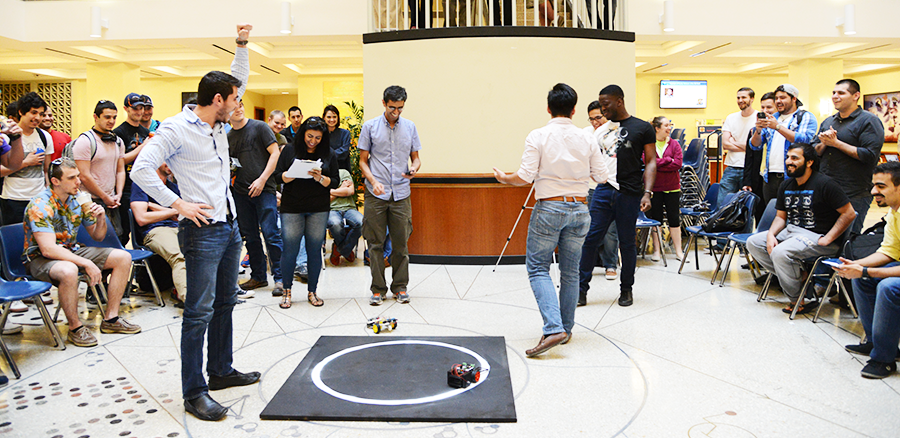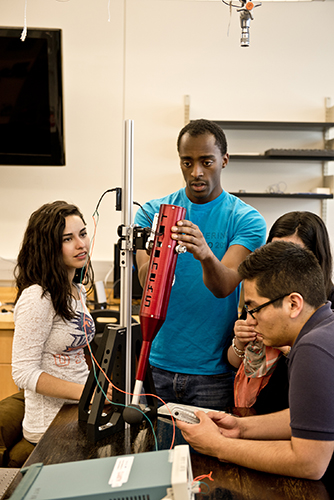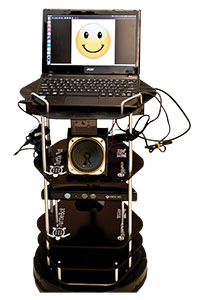
Robotics Frontiers
Research: Students are taking engineering skills to new levels, including bots that interact with humans
The cheering of excited students echoed through the atrium of the Biotechnology, Sciences and Engineering Building, coaxing the curious out of their offices and to the overlooking stories to investigate. The Battling Rowdy Bots had begun.
It was late afternoon, just after the College of Engineering's annual Technology Symposium, and on the ground floor, students in Pranav Bhounsule's mechatronics class fought to win. Well, more accurately, their robots did the fighting. The robot combat was part of the class's final, and it was certainly popular, attracting people four floors up to watch what was unfolding.
Bhounsule, a mechanical engineering assistant professor, was one of 40 new faculty researchers to join UTSA in fall 2014. His enthusiasm in the lab adds to an already well-established robotics curriculum that includes the work of the Department of Electrical and Computer Engineering's Mo Jamshidi. A Lutcher Brown Endowed Chair and Professor, Jamshidi is also the director of the university's Autonomous Control Engineering laboratory.
Senior engineering students who worked with Bhounsule say he has brought energy, excitement and support to the program. "He's also really pushed mentorships, and he's always helping us in the robotics lab," says Christian Trevino, a mechanical engineering senior who worked in the lab for her capstone project with three other teammates.
Along with their time in the robotics lab, Trevino, Racquel De La Garza, Robert Brothers and Eric Sanchez spent more than 250 hours in a machine shop to make 58 parts for Ein, a robotic leg meant to be part of a quadruped industrial robot. They also created a 3D-printed toy of a wolf that incorporated the leg design.
More and more jobs in the U.S. require some skill in science, technology, engineering and mathematics, according to STEMconnector, a consortium of companies, nonprofits, educators and other experts working to provide resources and services related to all things STEM. Robotics are seen as a good way to get students at younger ages interested in STEM fields, and robot competitions have been on the rise.
"Dr. Bhounsule is exactly the type of faculty member we aim to hire," says JoAnn Browning, dean of the College of Engineering. "His excellent educational credentials, coupled with his experiences working at Carnegie Mellon and with Disney, enable him to bring really exciting and unique elements of robotics to our engineering students."
Prior to graduation this spring, electrical engineering senior Roberto Mexquitic had already used the work he did on his team's capstone project for his job search. "I'm in my second round of interviews at one company, and I think [human-interaction robotics project] SHUSHbot made a difference," he said a week before the final project was due.
Mexquitic and his teammates worked on one of two senior capstone projects that involved human-interaction robots. SHUSHbot (or Smart Humanoid for Silencing Humans) was designed and programmed to tell people to quiet down in a library setting. A yellow smiley face shows up on a laptop "head" as the robot travels around to tell patrons they are being a bit too rambunctious.
Other projects designed by UTSA students included GuideBot (a robot programmable to give directions around any campus) and a rimless wheel made of mostly 3D-printed materials (essentially a set of "legs" radiating out on a wheel-like spokes but without the outer rim).
Rico Jovanni Ulep and Scott Miller have an ideal use in mind for their rimless wheel project. Now, if only they could get Curiosity back to Earth from its Mars mission. The wheels on the robotic rover have suffered damage because of the unexpectedly rugged conditions. "Legged robotics are good on rough terrain," Miller says, "so Mars or even the lunar surface, for example, would be ideal for a rimless wheel."
Sparking interest in STEM is a mission of Bhounsule's, who says he chose to come to UTSA because the university strives to balance teaching with research. "I think UTSA is one of the rare [research-focused] schools that also prioritizes teaching. The vision is to become Tier One but also one of the big things you do here is educate first-time college students."
To help with that mission, Bhounsule hopes to focus on outreach to high schools. He also believes mentoring minorities underrepresented in the field is imperative. He points out that Hispanics are the fastest growing population in the country but represent only 5 percent of minorities getting STEM degrees. By bringing minorities into the field and providing outreach and mentoring, Bhounsule says, those students can in turn become ambassadors for STEM.
SHUSHbot project teammate Javier Gonzalez is one such student. From a low-income area in San Antonio, Gonzalez says he knew he wanted to study engineering but didn't know which discipline to pursue. "In my last semester of high school a college graduate came to volunteer and teach us about circuits," he says. "I knew I wanted to pursue robotics as a kid, but once I saw what circuits could do, I made sure I got into the electrical engineering school. For me, to go back and make an impact in someone's life — like that one person did for me — will be a great satisfaction."
–Michelle Mondo


